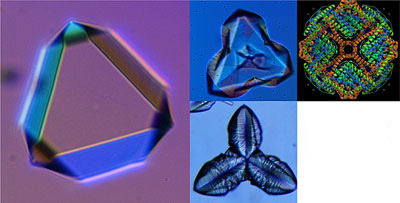TOP > Report & Column > The Forefront of Space Science > 2004 > New Developments in Space Science>
![]()

At the establishment of JAXA (Japan Aerospace Exploration Agency), our research focused on the use of the International Space Station (ISS) and was defined as a new field in space science called "Space-Environment Utilization Science." In order to make this new field a research pillar for space science, two new organizations were established within JAXA's Institute of Space and Astronautical Science: the Space Biology and Microgravity Science Department and the ISS Science Project Office. In this article, I will introduce some of the scientific results achieved so far in space-environment utilization. The space environment in which operates an orbital spaceship (ISS, Space Shuttle, etc.) has several unique features that cannot be obtained on earth, e.g., vacuum and no-gravity (microgravity) states, and radiation and solar energy that are provided by the vastness of outer space. Among these, microgravity is one environmental factor which is highly useful for science as it cannot be obtained on the ground for long duration and with high quality. Microgravity has the following features:
Past results of space experiments Previous microgravity experiments have yielded the following results:
Unveiling of the crystal-growth mechanism There are still many scientific issues to be solved concerning the crystal-growth mechanism for numerous reasons: difficult to observe directly atomic and molecular behavior during crystal growth and number of complex phenomena since convection influences heat and material transportation to the growth boundary face. As convection can be controlled in microgravity, it is possible to transport heat and material by diffusion. Creating easy-to-understand conditions by simplifying phenomena like this, conducting crystal growth experiments further the understanding of the mechanism. Below, I explain two typical researches currently under way. Single-crystal growth research of homogeneous composition In0.3Ga0.7As In this research, a model control method was successfully devised for heat/material transportation in order to obtain a crystal of homogeneous composition, which is difficult to produce on the ground. In0.3Ga0.7As (Indium, Gallium, Arsenic) is a promising semiconductor wafer for the next-generation of optical-communication laser devices. When InGaAs is used for wafers, output degradation at high temperatures (over 70 deg C) is reduced compared to the currently, widely used laser devices for inter-city communication. It provides stable operation without a cooling system. Producing homogeneity in the wafer surface is, however, difficult since InAs and GaAs are mixed. Thus, until recently, only poor homogeneous crystals of about 5 mm in length have been produced. To overcome this problem, we set up a model to obtain homogeneous composition and grew crystals based on the model. Specifically, we dissolved InAs in strips, reduced the sample diameter to 2 mm, and controlled heat/material transportation while constraining convection. As a result, we succeeded in growing extremely homogeneous single crystals of InAs composition 0.30±0.01 and more than 35 mm in length for the first time in the world (Fig. 1 and 2). We are now planning an experiment to grow semiconductors with over 10 mm diameter under microgravity. Meanwhile, we believe that ca. 5 mm-square wafers can be produced on the ground, and are trying to produce larger crystals. If we succeed, it will be an epoch-making event in that the outcome of microgravity-environment utilizing research would have important spin-off for the society.  Fig. 1 Cross section of a single In0.3Ga0.7As crystal grown (single crystal area: 35 mm).  Fig. 2 Sample of axial-direction composition distribution of grown crystals.
|
|||||





